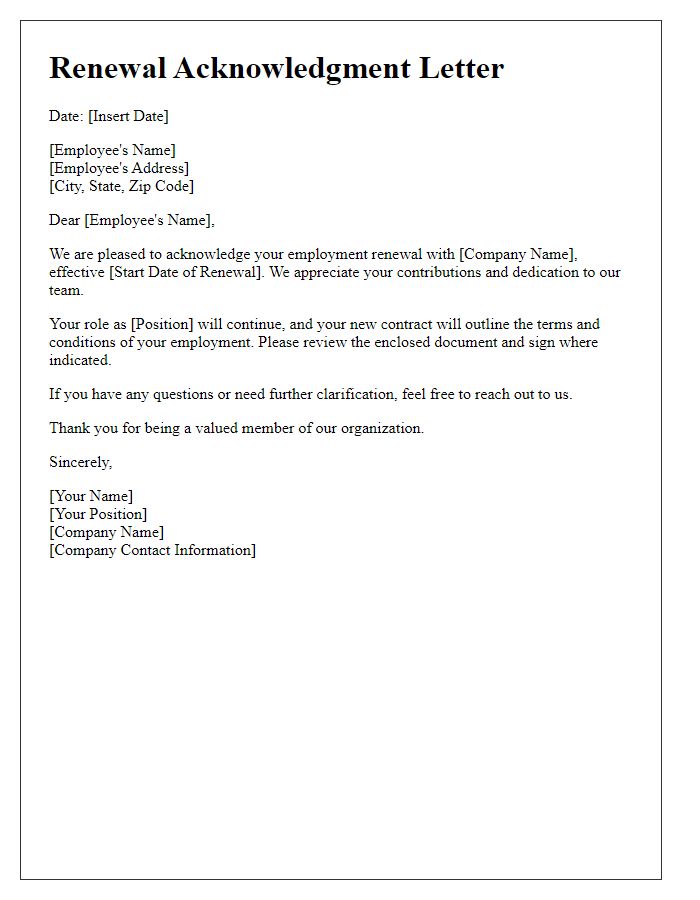Renewing an employee contract is a significant step that underscores the value of talent within an organization. In this article, we'll explore the essential elements to include in a contract renewal letter, helping you maintain clarity and professionalism in your communications. Understanding the nuances of contract renewal can foster a stronger employer-employee relationship and pave the way for future success. Ready to dive deeper into the art of crafting the perfect renewal letter? Let's get started!

Employee Details and Position
Employee contracts play a crucial role in defining the terms of employment, including the position, responsibilities, and salary. The employee's details include personal identification information, such as name and address (street, city, zip code), along with their job title, such as Senior Marketing Manager, which outlines their specific role within the organization. This position typically entails overseeing marketing strategies and campaigns that align with company goals, ensuring growth, and enhancing brand visibility. Additionally, important dates should be incorporated, such as the start date of the renewed contract and the duration of employment, which provides clarity on the continuation of their service. Performance metrics may also be referenced to highlight expectations and areas of assessment as part of the renewal process.
Renewal Terms and Conditions
An employee contract renewal involves specific terms and conditions that outline the new employment agreement. Key elements include the renewal duration, typically one year, starting from the initial contract expiry date. Salary adjustments often align with current market standards, reflecting performance evaluations conducted by the Human Resources department. Benefits may include health insurance coverage under the Comprehensive Care Policy, retirement plan contributions to a 401(k), and paid time off days, which commonly amount to fifteen annually. Additionally, compliance with company policies outlined in the Employee Handbook is mandatory, including codes of conduct and confidentiality agreements. Performance expectations and potential salary bonuses might be discussed in annual reviews, ensuring alignment with organizational goals set by the executive leadership team. The renewal process requires both parties to officially sign and date the new contract to validate the agreement legally.
Salary and Benefits
During the employee contract renewal process, it is essential to outline the terms regarding salary and benefits clearly. The base salary figures should reflect current industry averages and any adjustments based on performance reviews, such as increases of 5% to 10%. In addition, benefits must be detailed, including health insurance plans like PPO or HMO options, retirement plan contributions (like a 401(k) with matching up to 5%), and other perks such as paid vacation days (typically 10 to 15 per year), sick leave, and potential for bonuses based on company performance metrics. All information should comply with local labor laws and regulations, ensuring clarity in the renewal document to foster employee satisfaction and retention.
Employment Duration
An employee contract renewal often includes a clearly defined employment duration, typically specifying the new term of employment following the renewal process. For instance, a standard duration may range from one year to three years, depending on company policy, individual performance, and business needs. This duration might also incorporate specific start and end dates, such as January 1, 2024, to December 31, 2026, ensuring both the employer and employee have a mutual understanding of the timeline. In some cases, provisions for early termination or extension options could also be included, allowing for flexibility while outlining significant milestones or review periods throughout the employment duration. Such detailed terms help establish clarity regarding employment expectations and legal protections.
Signature and Acknowledgment
The signature and acknowledgment section in an employee contract renewal serves as a crucial final step in formalizing the agreement between the employer and employee. This section typically includes a designated space for both parties to affix their signatures, signifying acceptance of the terms and conditions outlined in the contract renewal. The employee's name, job title, and date of signature are included to ensure clarity and record-keeping. The employer, often represented by a higher authority such as a manager or HR director, also signs in a similar manner. This process may occur at the company's headquarters, such as the main office located in New York City, or through electronic means, ensuring that both parties retain a copy for their records. Documenting this acknowledgment not only reinforces the commitment to the stipulated terms but also solidifies the professional relationship for the upcoming contractual period.













Comments